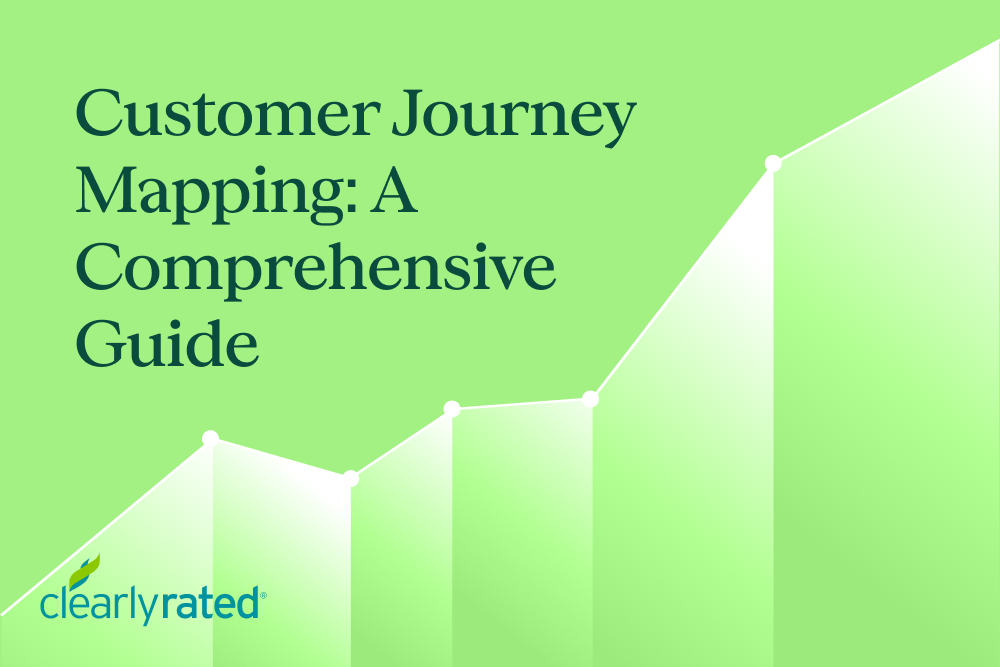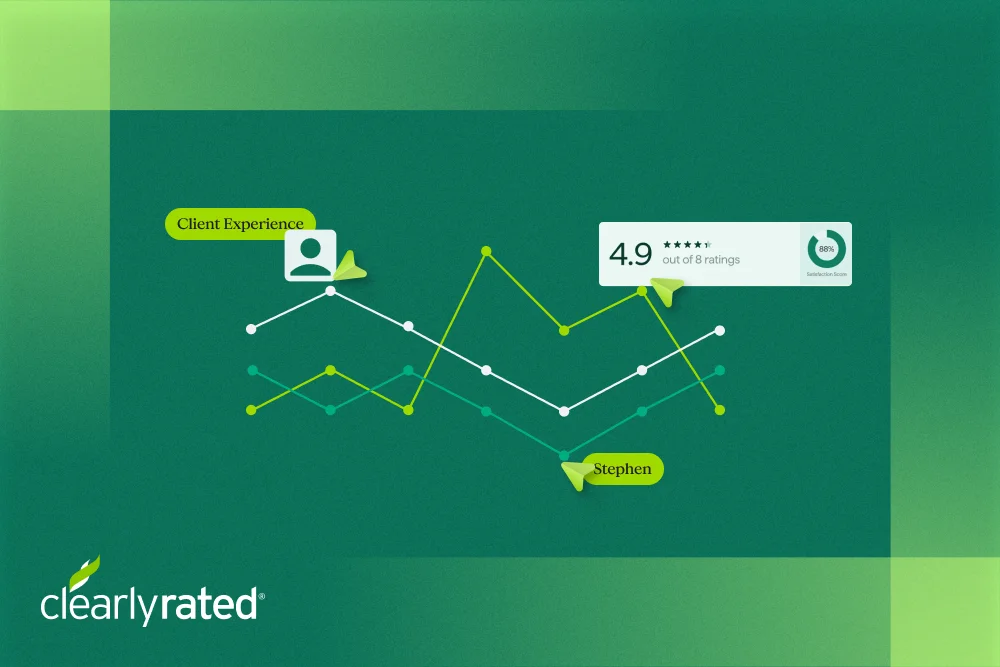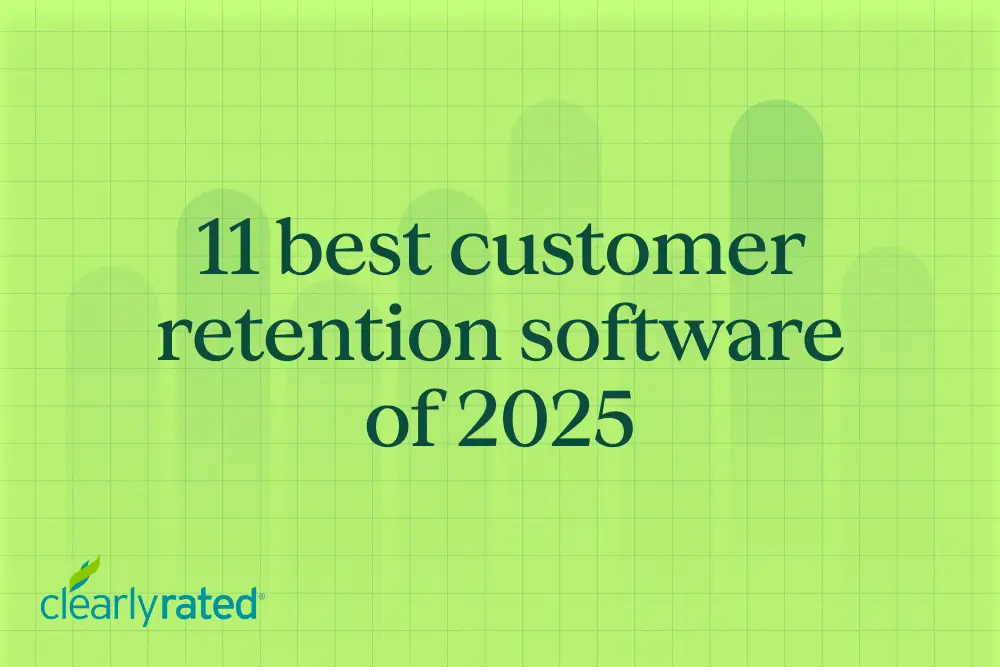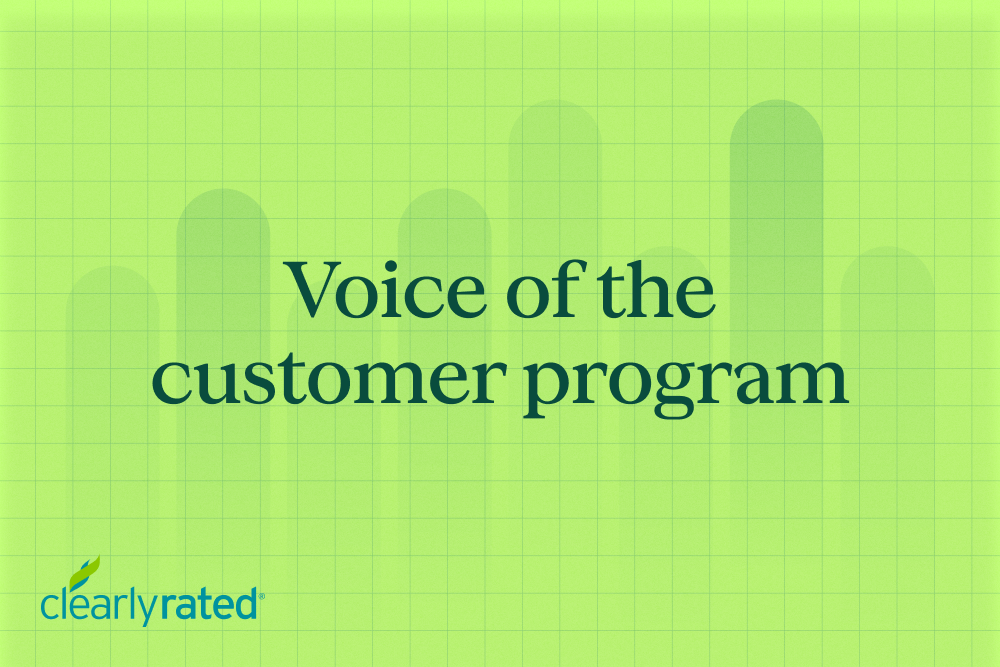Customer Journey Mapping: A Comprehensive Guide to Keep Customers Hooked, Not Hunting

- Customer acquisition is costly, but poor retention wastes that investment and erodes long-term growth.
- Customer journey mapping visualizes every stage of the buying experience to identify pain points, gaps, and opportunities.
- Key benefits include improving customer experience, aligning internal teams, allocating resources strategically, and boosting loyalty.
- Effective maps are built on real customer data, clear personas, critical touchpoints, emotions, and decision-making moments.
- Journey maps must be updated continuously using customer feedback, analytics, and tools like ClearlyRated to stay relevant and actionable.
Getting new customers is more challenging (and more expensive) than ever. With so many choices, low switching costs, and sky-high expectations, businesses are spending big to win them over—$523 per customer for B2B eCommerce and $702 for SaaS, according to a report by First Page Sage.
But here's the kicker: If you're not keeping those customers around, all that money and effort go to waste. Every lost customer means lost revenue, missed growth opportunities, and possibly bad word-of-mouth.
That's why understanding the customer journey is so important. When you know exactly where customers drop off, get frustrated, or lose interest, you can fix those gaps, improve their experience, and keep them coming back.
This blog will explore how customer journey mapping helps reduce churn, boost loyalty, and make every customer interaction count.
What is Customer Journey Mapping?
Let's say you're a procurement manager at a manufacturing company searching for a new software solution. You check out a vendor's website, but the pricing and product details are vague, and there's no sign of case studies for your industry. You fill out a contact form and get a generic email days later with no real answers.
When you finally speak with a sales rep, they talk in circles about features you don't need instead of focusing on your problem. Meanwhile, a competitor offers a straightforward demo, industry-specific insights, and a rep who actually listens, so you go with them instead.
This is precisely why customer journey mapping matters in B2B. It helps businesses pinpoint where potential customers drop off, what frustrates them, and what makes them convert. If a SaaS company notices prospects abandon sign-ups before a demo, it could mean their process is too complicated or lacks clear next steps. Fixing that with a more straightforward sign-up flow, better follow-up emails, or a quick-start guide could turn lost leads into long-term customers.
It's not just about having a great product. It's about making every buying journey frictionless, intuitive, and helpful.
Why is Customer Journey Mapping Important?
Decision-makers now demand seamless, self-service experiences, personalized interactions, and frictionless omnichannel engagement. Customer journey mapping helps bridge this gap, providing a data-driven, outside-in approach to understanding customer behavior. It uncovers hidden pain points, streamlines interactions, and ensures that every touchpoint adds value rather than friction. Here's why it's critical:
Understanding Customer Behavior and Expectations
B2B buyers now expect seamless, personalized experiences akin to B2C interactions. According to McKinsey, approximately 70% of B2B decision-makers are open to making purchases exceeding $50,000 through self-service or online channels. This shift underscores businesses' need to understand and cater to these evolving preferences.
A journey map helps companies visualize the buying process—from awareness to conversion—and pinpoint where prospects drop off. Are leads abandoning demos because of slow response times? Are buyers frustrated by a complex checkout process? These insights drive improvements that align with customer expectations.
Enhancing Customer Experience Across Touchpoints
With B2B marketing teams managing an average of 10.2 channels in 2024, maintaining consistency across all touchpoints is paramount. A well-constructed customer journey map helps businesses ensure that clients receive a cohesive and satisfying experience whether they interact via social media, the company website, or direct communication.
For example, suppose a prospect engages with LinkedIn content, downloads a whitepaper, and later speaks with sales. In that case, each interaction presents different messaging and value propositions, creating confusion. Journey mapping ensures consistency, so whether a customer interacts via a chatbot, an email, or a sales rep, the experience is seamless and cohesive.
Driving Customer-Centric Business Strategies
Studies show that customer-centric organizations are 60% more profitable than those that aren't (Deloitte, 2024). Take Amazon Business, which disrupted B2B procurement by offering transparent pricing, self-service ordering, and AI-powered recommendations, something traditional suppliers had overlooked.
They built their strategy around customer journey insights, proving that customer-centricity isn't just about satisfaction; it's a competitive advantage. As organizations map the customer journey, they can gain insights into client needs and expectations, allowing them to tailor their offerings and interactions more effectively.
Key Benefits of Customer Journey Mapping
Customer journey mapping is not just a diagnostic tool. It's a growth strategy. It empowers businesses to move beyond reactive problem-solving and towards proactive customer experience design. Companies can enhance engagement, improve loyalty, and ultimately drive sustainable success by understanding customer psychology, refining interactions, and leveraging data-driven insights.
Here are five significant benefits of customer journey mapping for B2B companies:
Decoding Buyer Psychology
Customers don't always express their frustrations openly, but their actions reveal valuable insights. Journey mapping helps businesses connect the dots between customer expectations, behaviors, and emotions, providing a clearer picture of what truly matters. This deeper understanding enables companies to proactively address pain points, refine messaging, and tailor offerings to meet evolving needs.
Turning Touchpoints into Opportunities
A seamless customer journey isn't just about meeting expectations—it's about exceeding them at every stage. Businesses can eliminate friction, reduce confusion, and enhance engagement by identifying critical touchpoints. Whether improving website navigation, streamlining support interactions, or refining the onboarding process, journey mapping ensures a consistent and positive experience across all channels.
Driving Cross-Functional Collaboration
A great customer experience isn't the responsibility of just one team. It requires alignment across sales, marketing, customer service, and operations. Journey mapping breaks down internal silos, fosters collaboration, and creates a shared vision for delivering exceptional service. When teams work together toward a common goal, businesses can innovate faster, resolve issues more efficiently, and make a unified brand experience.
Smarter Resource Allocation
Instead of making decisions based on assumptions, journey mapping provides concrete data on what's working and what's not. This insight helps businesses prioritize high-impact areas, ensuring time, budget, and efforts are focused on where they will deliver the most significant returns. Whether optimizing marketing spend, improving product features, or enhancing customer support, companies can invest strategically for maximum business impact.
Boosting Retention, Loyalty, and Advocacy
A seamless and engaging journey transforms one-time buyers into long-term customers and brand advocates. Satisfied customers are more likely to stay loyal, refer others, and engage with the brand over time. Journey mapping helps businesses identify and strengthen key loyalty drivers, ensuring customers don't just return—but actively promote the brand, fueling organic growth and long-term profitability.
Essential Components of a Customer Journey Map
Customer journey maps come in many forms, but their effectiveness isn't about how visually appealing they are. It's about the clarity and depth of insight they provide. Instead of focusing on aesthetics, prioritize key elements that ensure a comprehensive, actionable, and customer-centric map.
Here are the essential components every customer journey map should include:
Customer Personas
A strong journey map starts with a detailed representation of your ideal customer. Who are they? What are their needs, challenges, and motivations? Consider factors like:
- Demographics (age, industry, job role)
- Technology use (preferred devices, communication channels)
- Pain points (what obstacles they face in their journey)
- Buying behavior (what influences their decisions)
Creating multiple personas helps tailor the journey for different customer types, ensuring a more personalized and targeted experience.
Customer Goals and Desired Outcomes
Understanding what your customers want to achieve at each stage of their journey allows you to address frustrations and deliver value proactively. Every interaction should be designed with a clear answer to the following:
- What does the customer hope to accomplish?
- What barriers might prevent them from achieving it?
- How can we enhance the process to meet their expectations?
By mapping desired outcomes, you can align your processes with customer success rather than just business efficiency.
Key Steps in the Journey
Mapping out the sequence of events, from initial awareness to post-purchase engagement, provides a big-picture view of the customer experience.
It highlights:
- How customers move through each stage
- Where delays, inefficiencies, or confusion may occur
- Which areas need process improvements or redesigns
- A clear step-by-step outline ensures every transition feels seamless and intuitive for the customer.
Customer Touchpoints
Every interaction between your business and the customer—online, in person, or through support channels is a touchpoint. These moments define how customers perceive your brand.
- Common touchpoints include website visits, emails, sales calls, social media, customer support, and product usage.
- New touchpoints emerge as businesses expand and digitize—are you keeping up with them?
- Evaluating touchpoints ensures consistency and reliability across every platform.
A well-optimized touchpoint strategy keeps customers engaged and moving forward in their journey.
Key Decision Points
Certain touchpoints carry more weight than others—they are critical decision-making moments that can make or break the relationship with your customer.
- Joyous moments of truth reinforce trust and push customers closer to conversion.
- Negative moments of truth create frustration and risk customer churn.
Identifying these high-impact moments lets you prioritize improvements where they matter most, ensuring that key interactions leave a lasting, positive impression.
How to Create a Customer Journey Map
Step 1: Set Clear Business Goals
Before mapping the journey, define your goals. Is your focus on improving a specific touchpoint, optimizing an entire process, or redesigning the customer experience from scratch?
Consider the broader impact. Do you want to increase retention, boost conversions, or refine post-purchase support? Setting a clear objective ensures that the journey map remains focused, actionable, and aligned with business priorities.
Step 2: Define and Build Customer Personas
Not all customers have the same needs or follow the same path. Develop detailed personas and fictional representations of different customer segments based on real data. These personas should capture demographics, behaviors, pain points, motivations, and buying habits. By understanding who your customers are, you can tailor experiences, anticipate challenges, and create solutions that truly resonate.
Step 3: Identify Key Customer Touchpoints
Customers interact with your business through multiple channels, including website visits, emails, social media, sales calls, customer support, in-person meetings, and more. Identifying these touchpoints helps you see where engagement happens, where drop-offs occur, and where opportunities exist to enhance the experience.
Remember, studies show that a typical B2B customer engages with a company 13 times before purchasing; each interaction should be optimized to move the customer forward.
Step 4: Map Customer Emotions and Pain Points
A great journey map goes beyond touchpoints. It captures the customer's emotions, frustrations, and expectations at each stage. This step involves analyzing feedback from surveys, social media, reviews, and direct customer interviews to understand what delights customers, what frustrates them, and where they struggle most. You can proactively fix bottlenecks, eliminate inefficiencies, and enhance customer satisfaction by pinpointing these pain points.
Step 5: Visualize the Customer Journey Stages
Organize the journey into clear stages—from awareness and consideration to purchase and post-sale engagement. Each stage should outline:
- The customer's goal at that point
- The actions they take
- The challenges they face
- The emotions they experience
This structured approach helps teams across departments align on priorities and create a more seamless, customer-centric experience.
Step 6: Validate and Continuously Improve the Map
A customer journey map is not a static document; it should evolve according to customer behavior, market trends, and business objectives. Once the map is created, test it with real customers through interviews, feedback sessions, and data analysis. Look for gaps and adjust based on new insights. Regularly updating your map ensures that your business remains agile, responsive, and consistently focused on delivering exceptional customer experiences.
Data & Tools Needed for Effective Customer Journey Mapping
Gathering Customer Insights Through Surveys & Analytics
Understanding the customer journey starts with collecting the correct data. ClearlyRated provides businesses with a robust survey and analytics platform to capture real-time customer feedback at critical touchpoints. With customizable surveys, companies can gather Net Promoter® Score (NPS®), and other key performance metrics to pinpoint strengths and areas for improvement. These insights help companies make data-driven decisions that enhance customer experience and drive loyalty.
Using Heatmaps & AI for Deeper Analysis
For companies looking to go beyond traditional surveys, heatmaps and AI-driven analytics provide deeper insights into user behavior. Heatmaps visually represent how customers navigate websites, highlighting friction points that may hinder conversions. AI-powered sentiment analysis tools process open-ended responses, identifying trends and emotions that might be missed in quantitative data. Platforms like Hotjar and Crazy Egg help businesses visualize engagement, while AI-powered tools like Clearlyrated analyze customer sentiment to uncover hidden frustrations and opportunities for improvement.
Best Software & Tools for Customer Journey Mapping
Mapping the customer journey requires specialized tools that combine customer data, touchpoints, and feedback. Meanwhile, customer experience platforms like Clearlyrated integrate feedback data into journey maps, helping businesses connect customer insights with actionable improvements. By leveraging these tools, organizations can create seamless, personalized experiences that drive engagement and retention.
Common Mistakes to Avoid When Creating a Customer Journey Map
Relying on Assumptions Instead of Data
One of the biggest mistakes companies make is building a customer journey map based on internal assumptions rather than actual customer insights. It is easy to assume you know what customers want. Still, without accurate data such as surveys, interviews, behavioral analytics, and feedback, you risk designing an experience that does not align with reality. A journey map should be rooted in facts, not guesswork.
Ignoring Post-Purchase and Retention Stages
Many businesses focus heavily on the pre-purchase journey, including awareness, consideration, and decision-making, while neglecting what happens after a customer buys. However, retention, loyalty, and advocacy are just as critical. Customers who experience frustration with onboarding, lack of support, or unclear renewal processes may switch to a competitor. A well-rounded journey map includes the entire customer lifecycle, from acquisition to long-term engagement.
Not Updating the Journey Map Based on Real-Time Data
Customer needs, behaviors, and expectations evolve, and so does your journey map. A static map not revisited regularly can quickly become outdated, leading to blind spots in your customer experience strategy. Regularly analyzing feedback, monitoring behavioral data, and adapting the map ensures it remains relevant and actionable. Treat it as a living document that evolves with your business and customers.
How to Continuously Optimize Your Customer Journey Map
A customer journey map is not a one-time project; it requires ongoing refinement to stay relevant and practical. As customer behaviors shift and new technologies emerge, businesses must continuously analyze and improve their journey maps to maintain a seamless experience.
Act on Customer Feedback
Customer expectations evolve, and so should your journey map. Regularly collect feedback through surveys, reviews, and direct interactions to identify pain points and areas of improvement. Implementing customer insights ensures your journey map reflects real-world experiences rather than outdated assumptions.
Monitor Key Metrics and Real-Time Data
Tracking metrics such as conversion rates, churn rates, and customer satisfaction scores helps measure the effectiveness of each stage in the journey. Real-time analytics allows businesses to spot trends, detect bottlenecks, and make data-driven decisions to optimize touchpoints.
Align Teams and Processes
Customer experience spans multiple departments, from marketing and sales to customer support and product teams. Regular cross-functional collaboration ensures consistency across all touchpoints. Holding periodic reviews and workshops can help teams align with customer needs and company goals.
Leverage AI and Predictive Insights
AI-powered tools can analyze customer behavior, predict future actions, and suggest optimizations for the journey map. Predictive analytics can help businesses personalize experiences, anticipate customer issues, and proactively refine their strategies.
Test, Iterate, and Improve
Optimization is an ongoing process. A/B testing different approaches, experimenting with new engagement strategies, and refining communication touchpoints help improve the customer experience. Regularly updating the journey map ensures it remains an accurate and valuable tool for business growth.
Conclusion
A well-crafted customer journey map isn't just a one-time project; it's a powerful strategy for driving long-term customer loyalty and business growth. By continuously refining the journey based on honest feedback, businesses can eliminate friction, enhance engagement, and build stronger relationships.
ClearlyRated helps companies turn customer insights into action with real-time satisfaction tracking, NPS benchmarking, and industry-specific analytics. With proactive alerts for at-risk customers and validated reviews to strengthen your reputation, you can stay ahead of churn and drive meaningful improvements.
The key to customer retention lies in understanding and evolving with their needs. Take the next step, schedule a demo with ClearlyRated, and put customer feedback at the center of your success strategy.
FAQ:
1. What are the key stages of customer journey mapping?
Customer journey mapping typically includes five key stages:
- Awareness: The customer discovers your brand through marketing, referrals, or online research.
- Consideration: They evaluate your product or service, compare options, and seek reviews or testimonials.
- Decision: The customer makes a purchase or commitment based on perceived value and trust.
- Retention: Post-purchase support, onboarding, and engagement efforts ensure a positive experience.
- Advocacy: Satisfied customers become brand advocates, sharing positive feedback and driving referrals.
2. How does customer journey mapping improve business growth?
When you understand what your customers go through, you can remove obstacles, improve their experience, and ultimately boost growth. Journey mapping helps by:
- Increasing customer satisfaction and retention
- Improving conversion rates and reducing friction in the buying process
- Making marketing and sales efforts more targeted and effective
- Strengthening customer relationships and driving repeat business
A smoother journey means happier customers and happier customers lead to long-term success.
3. What tools can I use to create a practical customer journey map?
ClearlyRated is a powerful tool designed to help businesses refine their customer journey through real-time feedback and analytics. With ClearlyRated, you can:
- Collect actionable customer insights to identify strengths and pain points
- Track Net Promoter Score (NPS) and benchmark performance against industry standards
- Receive real-time alerts for detractors, allowing you to address concerns before they lead to churn
- Strengthen brand reputation with verified third-party reviews and ratings
FAQs


.png)






%5B1%5D.webp)







.png)











_%20The%20Ultimate%20Guide.png)




.png)




















%20in%20the%20Workplace.png)










.png)

%20and%20how%20can%20you%20increase%20it.png)
_%20A%20Step-by-Step%20Guide.png)

.png)
.png)




_.png)



%20in%202028.png)


_%20The%20Ultimate%20Guide%20(2024).png)











